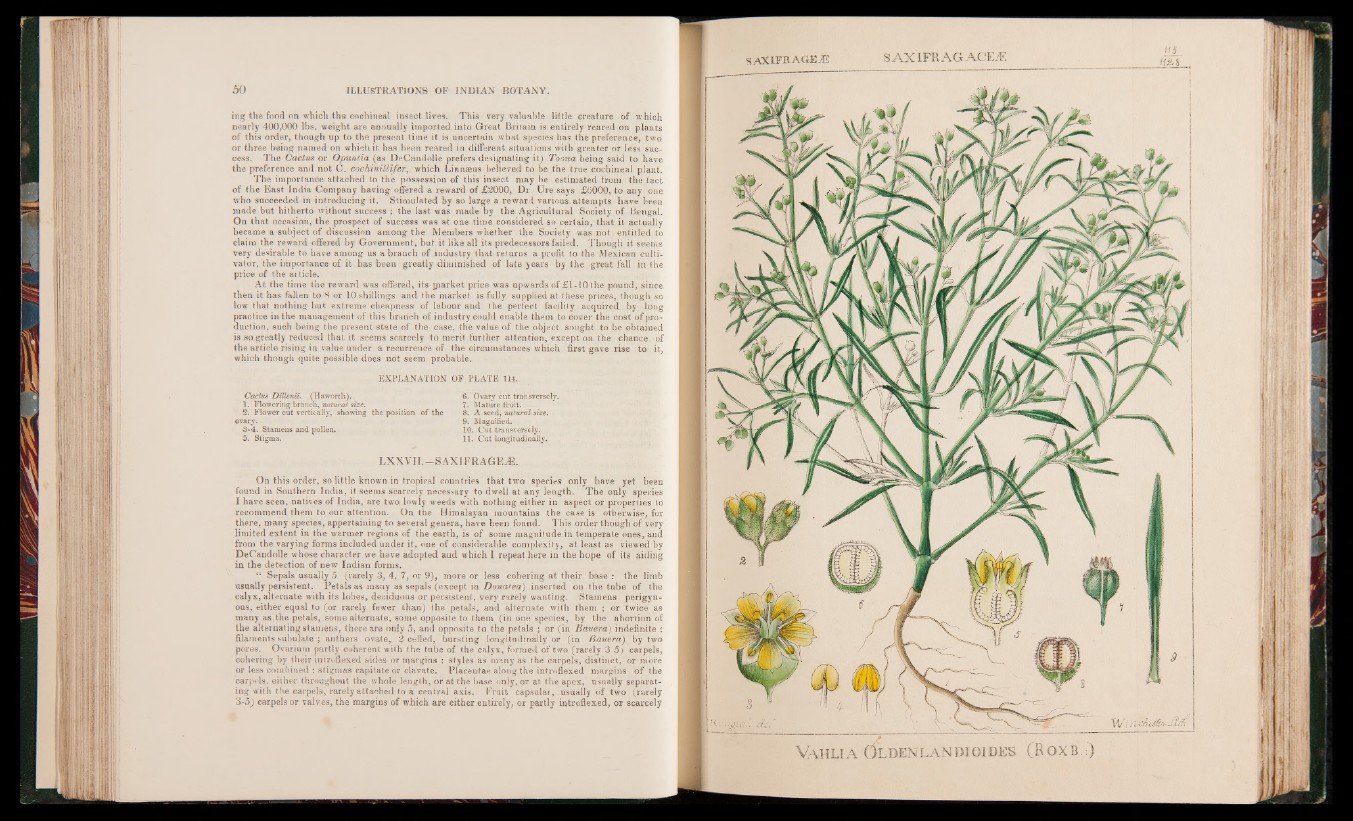
ing the food on which the cochineal insect lives. This very valuable little creature of which
nearly 400,000 lbs. weight are annually imported into Great Britain is entirely reared on plants
of this order, though up to the present time it is uncertain what species has the preference, two
or three being named on which it has been reared in different situations with greater or less success.
The Cactus or Opuntia (as DeCandolle prefers designating it) Toona being said to have
the preference and not C. cochinillifer, which Lin nee us believed to be the true cochineal plant.
The importance attached to the possession of this insect may be estimated from the tact
of the East India Company having offered a reward of £2000, Dr. Ure says £6000, to any one
who succeeded in introducing it.' Stimulated by so large a reward various attempts have been
made but hitherto without success ; the last was made by the Agricultural Society of Bengal.
On that occasion, the prospect of success was at one time considered so certain, that it actually
became a subject of discussion among the Members whether the Society was not entitled to
claim the reward offered by Government, but it like all its predecessors failed. Though it seems
very desirable to have among us a branch of industry that returns a profit to the Mexican cultivator,
the importance of it has been greatly diminished of late years by the great fall in the
price of the at tide.
At the time the reward was offered, its market price was upwards of £1-10 the pound, since
then it has fallen to 8 or 10 shillings and the market is fully supplied at these prices, though so
low that nothing but extreme cheapness of labour and the perfect facility acquired by long
practice in the management of this branch of industry could enable them to cover the cost of production,
such being the present state of the case, the value of the object sought to be obtained
is so greatly reduced that it seems scarcely to merit further attention, except on the chance of
the article rising in value under a recurrence of the circumstances which first gave rise to it,
which though quite possible does not seem probable.
EXPLANATION OF PLATE 114.
Cactus Dillenii. (Haworth).
1. Flowering branch, natural size.
2. Flower cut vertically, showing the position o f the
ovary.
3-4. Stamens and pollen.
5. Stigma.
6. Ovary cut transversely.
7. Mature fruit. __
8. A seed, natural size.
9. Magnified.
10. _Cut transversely.
11. Cut longitudinally.
LXXVII.—SAXIFRAGEÆ.
On this order, so little known in tropical countries that two species only have yet been
found in Southern India, it seems scarcely necessary to dwell at any length. The only species
I have seen, natives of India, are two lowly weeds with nothing either in aspect or properties to
recommend them to our attention. On the Himalayan mountains the case is otherwise, for
there, many species, appertaining to several genera, have been found. This order though of very
limited extent in the warmer regions of the earth, is of some magnitude in temperate ones, and
from the varying forms included under it, one of considerable complexity, at least as viewed by
DeCandolle whose character we have adopted and which I repeat here in the hope of its aiding
in the detection of new Indian forms.
“ Sepals usually 5 (rarely 3, 4, 7, or 9), more or less cohering at their base : the limb
usually persistent. Petals as many as sepals (except in Donated) inserted on the tube of the
calyx, alternate with its lobes, deciduous or persistent, very rarely wanting. Stamens perigyn-
ous, either equal to (or rarely fewer than) the petals, and alternate with them ; or twice as
many as the petals, some alternate, some opposite to them (in one species, by the abortion of
the alternating stamens, there are only 5, and opposite to the petals ; or (in Bauera) indefinite :
filaments subulate ; anthers ovate, 2 celled, bursting longitudinally or (in Bauera) by two
pores. Ovarium partly coherent with the tube of the calyx, formed of two (rarely 3 5; carpels,
cohering by their introflexed sides or margins : styles as many as the carpels, distinct, or more
or less combined : stigmas capitate or clavate. Placentae along the introflexed margins of the
carpels, either throughout the whole length, or at the base only, or at the apex, usually separating
with the carpels, rarely attached to a central axis. Fruit capsular, usually of two (rarely
3-5) carpels or valves, the margins of which are either entirely, or partly introflexed, or scarcely
SAXIFBAGEÆ
V A h l i a O l d e n l a n d i o i d e s ( R o x b . )
W i